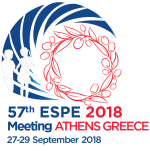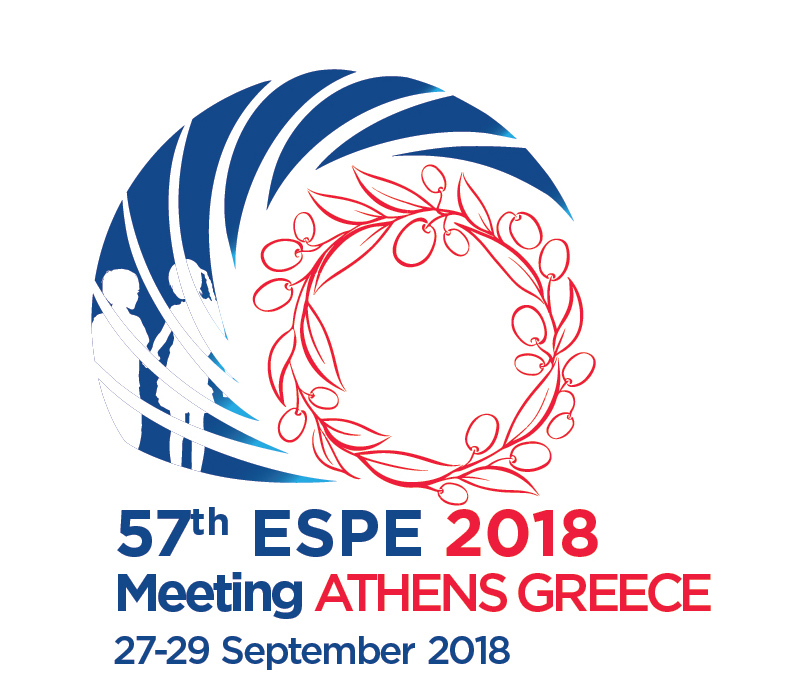
57th Annual ESPE
Athens,
Greece
27 Sep 2018 - 29 Sep 2018

Poster Presentations
Thyroid P2
hrp0089p2-p376 | Thyroid P2 | ESPE2018
Long Term Monitoring of Graves Disease in Children and Adolescents: Single Center Experience
Tunc Selma , Koprulu Ozge , Ortac Hatice , Nalbantoğlu Ozlem , Dizdarer Ceyhun , Demir Korcan , Ozkan Behzat
hrp0089p2-p377 | Thyroid P2 | ESPE2018
Effects of Thyroid Autoimmunity on Non-Alcoholic Fatty Liver Disease in Euthyroid Girls with Hashimoto’s Thyroiditis
İşguven Pınar , Ersavaş Dilek , Ersavaş Mehmet , Elmas Bahri
hrp0089p2-p378 | Thyroid P2 | ESPE2018
The Prevalence of Clinically Significant Anti-TPO Positivity in Children with HLA-Conferred Susceptibility to Type 1 Diabetes
Saare Liisa , Peet Aleksandr , Tillmann Vallo
hrp0089p2-p379 | Thyroid P2 | ESPE2018
Encephalopathy Associated with Autoimmune Thyroid Disease: A Case Report
Lantigua Hector , Yafi Michael
hrp0089p2-p380 | Thyroid P2 | ESPE2018
Celiac Disease Screening Should be Routinely Offered in Pediatric Population with Autoimmune Thyroid Disease
Resta Maria , Triantafyllou Panagiota , Agakidis Charalampos , Maliachova Olga , Christoforidis Athanasios
hrp0089p2-p381 | Thyroid P2 | ESPE2018
Autoimmune Thyroiditis in Klippel-Feil Syndrome with Arnold Chiari and Syringomyelia
Guidoni Elisa , Lotti Federica , Geronzi Ursula , Arianna Sorrentino Laura , Municchi Giovanna
hrp0089p2-p382 | Thyroid P2 | ESPE2018
Neonatal Monitoring of Newborns Born from Mothers with Graves’ Disease: Results of a Retrospective Monocentric Study
Dumaine Cecile , Crepon Sophie Guilmin , Pages Justine , Chevenne Didier , Rosenblatt Jonathan , Storey Caroline , Martinerie Laetitia , Carel Jean-Claude , Zenaty Delphine , Leger Juliane , Simon Dominique
hrp0089p2-p383 | Thyroid P2 | ESPE2018
A Successful Switch Experience from High-dose PTU to MMI on Day 4 of Graves’ Thyroid Storm in a 14-Year-Old Girl
Shinohara Hiroyuki , Iwabuchi Atsushi , Yamada Akiko , Kai Tomomi , Kamoda Tomohiro
hrp0089p2-p384 | Thyroid P2 | ESPE2018
Graves’s Disease During Pregnancy: The Impact on the Fetus and the Newborn
Belin Florine , Rodrigue Danielle , Claire Claire , Bouvattier , Teinturier Cecile , Fouati Khadidja , Linglart Agnes , Lambert Anne-Sophie
hrp0089p2-p385 | Thyroid P2 | ESPE2018
Thyroid Hormone Receptor β (THRB) Mutation: Two New Cases of Heterozygous Mutation with Significant Family History
Blackburn James , Senniappan Senthil , Giri Dinesh
hrp0089p2-p386 | Thyroid P2 | ESPE2018
Triac Treatment Response to Thyroid Hormone Resistantance
Cinaz Peyami , Uğurlu Aylin Kılınc , Doğer Esra , Akbaş Emine Demet , Bideci Aysun , Camurdan Orhun
hrp0089p2-p387 | Thyroid P2 | ESPE2018
Phenotype and Genotype of Four Patients with Thyroid Hormone Resistance Syndrome due to Mutations in the THRB Gene
Toumba Meropi , Neocleous Vassos , Fanis Pavlos , Skordis Nicos , Phylactou Leonidas A , Tanteles George A , Kyriakidou-Himonas Marinella , Picolos Michalis
hrp0089p2-p388 | Thyroid P2 | ESPE2018
Clinical Course in a Girl with Two hTPO Mutations – Homozygous c.1268G>A (p.Gly393Arg) and Heterozygous c.208C>G (p.Ala70Pro): 27 Years of Follow Up
Stoeva Iva , Mihova Kalina , Koleva Reni , Zheliaskov Mitko , Stoilov Boris , Kaneva Radka
hrp0089p2-p389 | Thyroid P2 | ESPE2018
A Neurological Disease Mimicking Central Hypothyroidism: MCT8 Deficiency
Demirbas Ozgecan , Eren Erdal , Tarim Omer
hrp0089p2-p390 | Thyroid P2 | ESPE2018
Multinodular Goiter in Childhood: Look for DICER1 Mutation
Suteau Valentine , Isabelle Souto , Natacha Bouhours-Nouet , Maryam Azgal , Justine Bailleul , Marie-Neige Campas , Aurelie Donzeau , Patrice Rodien , Regis Coutant
hrp0089p2-p391 | Thyroid P2 | ESPE2018
Application of Elastography in Assesment of Different Benign Thyroid Lesions in Children and Adolescents
Borysewicz-Sańczyk Hanna , Dzięcioł Janusz , Sawicka Beata , Florczykowska Patrycja , Przychodzen Małgorzata , Bossowski Artur
hrp0089p2-p392 | Thyroid P2 | ESPE2018
Clinical Characteristics and Predictive Factors for the Detection of Thyroid Cancer in Children with Thyroid Nodules
Suh Junghwan , Choi Han Saem , Kwon Ah Reum , Chae Hyun Wook , Kim Duk Hee , Kim Ho-Seong
hrp0089p2-p393 | Thyroid P2 | ESPE2018
Thyroid Nodules in Prader-Willi Syndrome
Grugni Graziano , Minocci Alessandro , Sartorio Alessandro , Crino Antonino
hrp0089p2-p394 | Thyroid P2 | ESPE2018
Early Medullary Thyroid Carcinoma (MTC) in an Infant with Multiple Endocrine Neoplasia Type 2B (MEN2B, RETS Mutation codon 891)
Alkhalaf Fawziya , Soliman Ashraf
hrp0089p2-p395 | Thyroid P2 | ESPE2018
Serum Level of Biotin Rather than the Daily Dose is the Main Determinant of the Interference on Thyroid Function Assays in Patients with Biotinidase Deficiency
Paketci Ahu , Kose Engin , Calan Ozlem Gursoy , Acar Sezer , Teke Pelin , Demirci Ferhat , Abacı Ayhan , Demir Korcan , Arslan Nur , Bober Ece
hrp0089p2-p396 | Thyroid P2 | ESPE2018
Thyroid Function Tests and Affecting Factors in Twins and Triplets
Kelesoglu Emre , Atay Zeynep , Abali Saygin , Atay Enver , Turan Murat , Gundogdu Semra , Ceran Omer
hrp0089p2-p397 | Thyroid P2 | ESPE2018
Hypothyroidism in a Child During Treatment with Nivolumab for a Glioblastoma
H Birkebaek Niels , Dahl Christine
hrp0089p2-p398 | Thyroid P2 | ESPE2018
Diagnosis and Clinical Course of Amiodarone Induced Hyperthyroidism in Three Adolescent Patients
Gesing Julia , Hoppmann Julia , Gebauer Roman , Pfaffle Roland , Bertsche Astrid , Kiess Wieland
hrp0089p2-p399 | Thyroid P2 | ESPE2018
Allogenic Bone Marrow Transplantation in Children: Effect on Thyroid Function
Vlachopapadopoulou Elpis Athina , Paisiou Anna , Stergiotis Stefanos , Ioannidou Eleni Dikaia , Goussetis Eugenios , Kafetzi Maria , Kitra Vassiliki , Michalacos Stefanos
hrp0089p2-p400 | Thyroid P2 | ESPE2018
Follow-up in Children with Non-obese and Non-autoimmune Subclinical Hypothyroidism
Ergin Zeynep , Savas-Erdeve Senay , Kurnaz Erdal , Cetinkaya Semra , Aycan Zehra
hrp0089p2-p401 | Thyroid P2 | ESPE2018
Clinical Management of Childhood Hyperthyroidism: A Longitudinal Study at a Single Center
Dos Santos Tiago Jeronimo , Martos-Moreno Gabriel , Munoz-Calvo Maria , Pozo Jesus , Rodriguez-Artalejo Fernando , Argente Jesus
hrp0089p2-p402 | Thyroid P2 | ESPE2018
Association of Thyroid Stimulating Hormone and Free Thyroxine with Cardiometabolic Risk Factors in Euthyroid Korean children and Adolescents Aged 10–18 Years: The Korean National Health and Nutrition Examination Survey 2015
Lim Jung Sub , Shim Young Suk , Kim Eun Young
hrp0089p2-p403 | Thyroid P2 | ESPE2018
Asymptomatic Hyperthyrotropinaemia in Children, Does it Correlate to true Thyroid Gland Dysfunction?
Kappou Kalliopi , Bisbinas Vasiliki , Karabouta Zacharoula
hrp0089p2-p404 | Thyroid P2 | ESPE2018
Hearing Loss Among Patients with Congenital Hypothyroidism
Almagor Tal , Nachtigal Dan , Sharoni Zohara , Elias-Assad Ghadir , Hess Ora , Havazelet Gilad , Tenenbaum-Rakover Yardena
hrp0089p2-p405 | Thyroid P2 | ESPE2018
Predictors of Permanent Congenital Hypothyroidism in Children
hrp0089p2-p406 | Thyroid P2 | ESPE2018
Absence of Uptake on Scintigraphy Does Not Always Correlate with Athyreosis: Re-evaluation of Patients Diagnosed with Athyreosis Over a 10 Year Period in the Republic of Ireland
McGrath N , Hawkes CP , Ryan S , Mayne P , Murphy NP
hrp0089p2-p407 | Thyroid P2 | ESPE2018
Bannayan-Riley-Ruvalcaba Syndrome with PTEN Mutation in a Patient Affected by Congenital Hypothyroidism due to TPO Gene Alteration
Vincenzi Gaia , Vigone Maria Cristina , Peroni Elena , Saracco Luca , Paesano Pier Luigi , Maggiore Riccardo , Mari Gilberto , Patricelli Maria Grazia , Weber Giovanna
hrp0089p2-p408 | Thyroid P2 | ESPE2018
The Congenital Hypothyroidism Screening Programme in a Sigle Italian Centre: a 5-Years Retrospective Study
Maggio Maria Cristina , Ragusa Saveria Sabrina , Aronica Tommaso Silvano , Granata Orazia Maria , Gucciardino Eleonora , Corsello Giovanni
hrp0089p2-p409 | Thyroid P2 | ESPE2018
Do Insulin Like Growth Factors also Influence Growth in Children with Congenital Hypothyroidism: A Cohort Analysis
Yadav Sangita , Goel Ruchi , Mantan Mukta , Mishra T K
hrp0089p2-p410 | Thyroid P2 | ESPE2018
Study of Hearing Function in Children with Congenital Hypothyroidism Attending Alexandria University Children’s Hospital
Elsayed Shaymaa , Wafa Ehsan , Elmoazen Doaa , Elsayed Haidy
hrp0089p2-p411 | Thyroid P2 | ESPE2018
Awareness of the Risks of Acquired Iodine Deficiency in Strict Vegan Diets
Brandt Agnieszka , Cheung Moira , Sakka Sophia , Ajzensztejn Michal , Hulse Tony
hrp0089p2-p412 | Thyroid P2 | ESPE2018
Thyroid Function in the Korean Obese Children and Adolescents: Korea National Health and Nutrition Examination Survey 2013 to 2015
An Youngmin , Eun Lee Ji , Ju Suh Young



